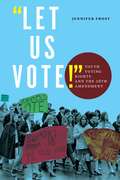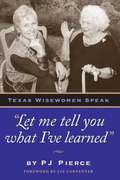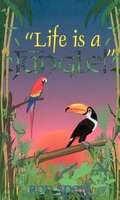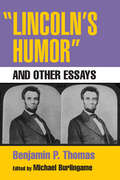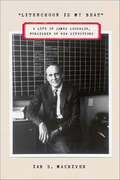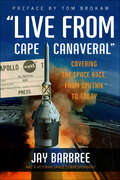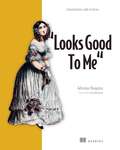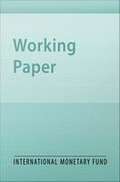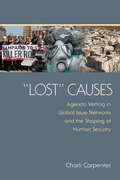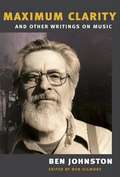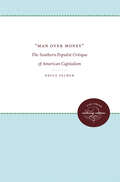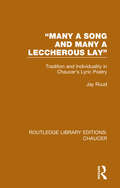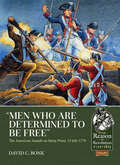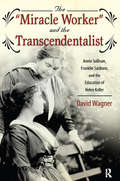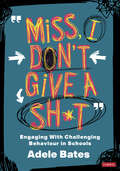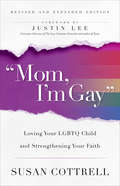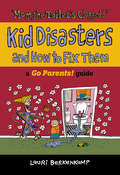- Table View
- List View
"Lee is Trapped, and Must be Taken": Eleven Fateful Days after Gettysburg, July 4–14, 1863
by Thomas J. Ryan Richard R. SchausThousands of books and articles examine nearly every aspect of the Civil War, but the important retreat of the armies from the Gettysburg battlefield to the Potomac River has been but little covered. Until now, no one had produced a critical analysis of the command decisions made during that fateful time based upon available intelligence. “Lee is Trapped and Must be Taken”: Eleven Fateful Days after Gettysburg, July 4 to July 14, 1863, by Thomas J. Ryan and Richard R. Schaus, now available in paperback, rectifies this oversight. This comprehensive day-by-day account, which begins after the end of the Gettysburg battle, examines how Maj. Gen. George G. Meade organized and motivated his Army of the Potomac in response to President Abraham Lincoln’s mandate to bring about the “literal or substantial destruction” of Gen. Robert E. Lee’s defeated and retreating Army of Northern Virginia. As far as Lincoln was concerned, if Meade aggressively pursued and confronted Lee before he could escape across the flooded Potomac River, “the rebellion would be over.” The long and bloody three-day battle exhausted both armies. Both commanders faced the difficult tasks of rallying their troops for more marching and fighting. Lee had to keep his army organized and motivated enough to conduct an orderly withdrawal into Virginia. Meade faced the same organizational and motivational challenges with the added expectation of catching and defeating a still-dangerous enemy. Central to their decision-making was the information they received from their intelligence gathering resources about the movements, intentions, and capability of the enemy. The eleven-day period after Gettysburg was a battle of wits to determine which commander better understood the information he received and directed his army accordingly. Prepare for some surprising revelations. Ryan and Schaus rely on a host of primary sources to craft their study, including letters, memoirs, diaries, official reports, newspapers, and telegrams. The threading of these intelligence gems creates a gripping narrative with a significant amount of new information—which the authors use to offer their own direct and often damning conclusions. “Lee is Trapped and Must be Taken” is a sequel to Thomas Ryan’s Spies, Scouts, and Secrets in the Gettysburg Campaign (Savas Beatie, 2015), the recipient of the Bachelder-Coddington Literary Award and Gettysburg Civil War Round Table Distinguished Book Award.
"Left-Wing" Communism, an Infantile Disorder
by V. I. LeninThis book describes the influence of left-wing Communism in different countries.
"Let Us Vote!": Youth Voting Rights and the 26th Amendment
by Jennifer FrostThe fascinating tale of how a bipartisan coalition worked successfully to lower the voting age“Let Us Vote!” tells the story of the multifaceted endeavor to achieve youth voting rights in the United States. Over a thirty-year period starting during World War II, Americans, old and young, Democrat and Republican, in politics and culture, built a movement for the 26th Amendment to the US Constitution, which lowered the voting age from twenty-one to eighteen in 1971. This was the last time that the United States significantly expanded voting rights.Jennifer Frost deftly illustrates how the political and social movements of the time brought together bipartisan groups to work tirelessly in pursuit of a lower voting age. In turn, she illuminates the process of achieving political change, with the convergence of “top-down” initiatives and “bottom-up” mobilization, coalition-building, and strategic flexibility. As she traces the progress toward achieving youth suffrage throughout the ’60s, Frost reveals how this movement built upon the social justice initiatives of the decade and was deeply indebted to the fight for African American civil and voting rights.2021 marks the fiftieth anniversary of this important constitutional amendment and comes at a time when scrutiny of both voting age and voting rights has been renewed. As the national conversation around climate crisis, gun violence, and police brutality creates a new call for a lower voting age, “Let Us Vote!” provides an essential investigation of how this massive political change occurred, and how it could be brought about again.
"Let me tell you what I've learned:" Texas Wisewomen Speak
by Pj PierceBarbara Jordan spoke for many Texas women when she told a reporter, "I get from the soil and spirit of Texas the feeling that I, as an individual, can accomplish whatever I want to, and that there are no limits, that you can just keep going, just keep soaring. I like that spirit." Indeed, the sense of limitless possibilities has inspired countless Texas women—sometimes in the face of daunting obstacles—to build lives rich in work, family, friends, faith, and community involvement.
"Let's Get a Pup!" Said Kate
by Bob GrahamA funny, warm story for every child who's wished for a puppy. There are lots of dogs of all shapes and sizes at the animal shelter. But Karen and her mom and dad know they want Dave the moment they see him. He's small and cute and a perfect fit for the end of Kate's bed. But then they see Rosy, who is old and gray and broad as a table... How can Kate and Mom and Dad take home just ONE dog when there are so MANY wonderful animals who need a home?
"Life Doesn't Wait": Romania’s Failure to Protect and Support Children and Youth Living with HIV
by Human Rights WatchMore than 7,200 Romanian children and youth aged 15 to 19 are living with HIV. The vast majority were infected with HIV between 1986 and 1991 as a direct result of government policies that exposed them to contaminated needles and "microtransfusions" in which small children were injected with unscreened blood in the mistaken belief that this would improve their health.
"Life Is a Jungle" (Book 2: The Rani Adventures)
by Ron SnellIn this delightfully written book, Ron continues his memoir. His parents are Wycliffe translators, who live much as the Machiguenga do. Ron spends much of his time with his Peruvian Indian friends, helping with projects, which often leads to fascinating and hilarious adventures. Ron loves this life, and he writes with a warmth and cleverness that makes this book hard to put down. The other books in this series are available from Bookshare.
"Light Out" and Modern Vietnamese Stories, 1930–1954 (NIU Southeast Asian Series)
by Paul Christiansen Quan Manh Ha"Light Out" and Modern Vietnamese Stories, 1930–1954, translated by Quan Manh Ha and Paul Christiansen, with an essay by Ngô Văn Giá, is the first anthology in English of colonial Vietnamese literature written by canonical authors. Light Out depicts colonial exploitation, impoverished peasants at the mercy of precarious crop cycles, and institutionalized corruption that pits peasants against village officials. Set over the course of a few days, the novella presents an intimate look into the rural society in northern Vietnam during the height of French colonialism, exposing the brutal realities of the period and the impact such deprivations have on the human spirit. The eighteen short stories included in this book thematically delineate colonial abuses, class discrimination, patriarchal expectations, and livelihoods tethered to an unstable environment. Aesthetically, they illuminate the impact of French literary traditions and Western thought on Vietnamese traditions of storytelling.
"Lincoln's Humor" and Other Essays
by Benjamin P. ThomasThis volume gathers the best previously unpublished and uncollected writings on Abraham Lincoln and Lincoln scholarship by one of his great biographers, Benjamin P. Thomas. A skilled historian and a masterful storyteller himself, Thomas was widely regarded as the greatest Lincoln historian of his generation. With these essays, he combines historical depth with narrative grace in delineating Lincoln's qualities as a humorist, lawyer, and politician. From colorful tall tales to clever barbs aimed at political opponents, Lincoln clothed a shrewd wit in a homespun, backwoods vernacular. He used humor to defuse tension, illuminate a point, put others at ease--and sometimes for sheer fun. From an early reliance on broad humor and ridicule in speeches and on the stump, Lincoln's style shifted in 1854 to a more serious vein in which humor came primarily to elucidate an argument. "If I did not laugh occasionally I should die," he is said to have told his cabinet, "and you need this medicine as much as I do." Thomas brings his deep knowledge of Lincoln to essays on the great man's tumultuous career in Congress, his work as a lawyer, his experiences in the Courts, and his opinions of the South. A gracious survey of Lincoln's early biographers, particularly Ida Tarbell, stands alongside an appreciation of Harry Edward Pratt, a key figure in the early days of the Abraham Lincoln Association. Thomas also assesses Lincoln's use of language and the ongoing significance of the Gettysburg Address. This diverse collection is enhanced by an introduction by Michael Burlingame, himself a leading biographer of Lincoln. Burlingame provides a balanced portrait of Thomas and his circuitous path toward writing history.
"Literchoor Is My Beat": A Life of James Laughlin, Publisher of New Directions
by Ian S. MacNivenA biography—thoughtful and playful—of the man who founded New Directions and transformed American publishingJames Laughlin—poet, publisher, world-class skier—was the man behind some of the most daring, revolutionary works in verse and prose of the twentieth century. As the founder of New Directions, he published Ezra Pound's The Cantos and William Carlos Williams's Paterson; he brought Hermann Hesse and Jorge Luis Borges to an American audience. Throughout his life, this tall, charismatic intellectual, athlete, and entrepreneur preferred to stay hidden. But no longer—in "Literchoor Is My Beat": A Life of James Laughlin, Publisher of New Directions, Ian S. MacNiven has given us a sensitive and revealing portrait of this visionary and the understory of the last century of American letters. Laughlin—or J, as MacNiven calls him—emerges as an impressive and complex figure: energetic, idealistic, and hardworking, but also plagued by doubts—not about his ability to identify and nurture talent but about his own worth as a writer. Haunted by his father's struggles with bipolar disorder, J threw himself into a flurry of activity, pulling together the first New Directions anthology before he'd graduated from Harvard and purchasing and managing a ski resort in Utah. MacNiven's portrait is comprehensive and vital, spiced with Ezra Pound's eccentric letters, J's romantic foibles, and anecdotes from a seat-of-your-pants era of publishing now gone by. A story about the struggle to publish only the best, it is itself an example of literary biography at its finest.
"Live from Cape Canaveral": Covering the Space Race, from Sputnik to Today
by Jay Barbree“From Sputnik to the International Space Station, Jay Barbree has seen it all, and reported it well. ‘Live from Cape Canaveral’ encapsulates the most technically exciting half century in history.” –Neil ArmstrongSome fifty years ago, while a cub reporter, Jay Barbree caught space fever the night that Sputnik passed over Georgia. He moved to the then-sleepy village of Cocoa Beach, Florida, right outside Cape Canaveral, and began reporting on rockets that fizzled as often as they soared. In "Live from Cape Canaveral," Barbree—the only reporter who has covered every mission flown by astronauts—offers his unique perspective on the space program. He shares affectionate portraits of astronauts as well as some of his fellow journalists and tells some very funny behind-the-scenes stories—many involving astronaut pranks. Barbree also shows how much the space program and its press coverage have changed over time. Warm and perceptive, he reminds us just how thrilling the great moments of the space race were and why America fell in love with its heroic, sometimes larger-than-life astronauts.
"Looks Good to Me": Constructive code reviews
by Adrienne BraganzaDeliver code reviews that consistently build up your team and improve your applications.&“Looks Good to Me&” offers a unique approach to delivering meaningful code reviews that goes beyond superficial checklists and tense critical conversations. Instead, you&’ll learn how to improve both your applications and your team dynamics. &“Looks Good to Me&” teaches you how to: • Understand a code review's benefits proactively prevent loopholes and bottlenecks • Co-create an objective code review system • Clarify responsibilities: author, reviewer, team lead/manager, and the team itself • Establish manageable guidelines and protocols • Align with your team and explicitly document the policies they will follow • Automate code quality with linting, formatting, static analysis, and automated testing • Compose effective comments for any situation • Consider combining code reviews with pair programming or mob programming • AI for code reviews Inside &“Looks Good to Me&” you&’ll find comprehensive coverage of every part of the code review process, from choosing a system to keeping reviews manageable for everyone involved. With this mix of tools, processes, common sense, and compassion, you&’ll run a highly effective review process from first commit to final deployment. Foreword by Scott Hanselman. About the technology Transform code reviews into the positive, productive experiences they&’re meant to be! Whether it&’s your code under the microscope or you&’re the one giving the feedback, this sensible guide will help you avoid the tense debates, fruitless nitpicking, and unnecessary bottlenecks you&’ve come to expect from code reviews. About the book &“Looks Good to Me&” teaches the considerate, common sense approach to code reviews pioneered by author Adrienne Braganza. You&’ll learn how to create a cohesive team environment, align review goals and expectations clearly, and be prepared for any changes or obstacles you may face. Along the way, you&’ll master practices that adapt to how your team does things, with multiple options and solutions, relatable scenarios, and personal tidbits. You&’ll soon be running highly effective reviews that make your code—and your team—stronger. What's inside • Why we do code reviews • Automate processes for code quality • Write effective comments About the reader For any team member, from developer to lead. About the author Adrienne Braganza is an engineer, speaker, instructor, and author of the bestselling book Coding for Kids: Python. Table of Contents Part 1 1 The significance of code reviews 2 Dissecting the code review 3 Building your team&’s first code review process Part 2 4 The Team Working Agreement 5 The advantages of automation 6 Composing effective code review comments Part 3 7 How code reviews can suck 8 Decreasing code review delays 9 Eliminating process loopholes 10 The Emergency Playbook Part 4 11 Code reviews and pair programming 12 Code reviews and mob programming 13 Code reviews and AI A Team Working Agreement starter template B Emergency Playbook starter template C PR templates D List of resources
"Lost Decade" in Translation: What Japan's Crisis could Portend about Recovery from the Great Recession
by Kenneth Kang Kiichi Tokuoka Murtaza SyedA report from the International Monetary Fund.
"Lost" Causes: Agenda Vetting in Global Issue Networks and the Shaping of Human Security
by Charli CarpenterWhy do some issues and threats—diseases, weapons, human rights abuses, vulnerable populations—get more global policy attention than others? How do global activist networks decide the particular causes for which they advocate among the many problems in need of solutions? According to Charli Carpenter, the answer lies in the politics of global issue networks themselves. Building on surveys, focus groups, and analyses of issue network websites, Carpenter concludes that network access has a direct relation to influence over how issues are ranked. Advocacy elites in nongovernmental and transnational organizations judge candidate issues not just on their merit but on how the issues connect to specific organizations, individuals, and even other issues.In "Lost" Causes, Carpenter uses three case studies of emerging campaigns to show these dynamics at work: banning infant male circumcision; compensating the wartime killing and maiming of civilians; and prohibiting the deployment of fully autonomous weapons (so-called killer robots). The fate of each of these campaigns was determined not just by the persistence and hard work of entrepreneurs but by advocacy elites' perception of the issues' network ties. Combining sweeping analytical argument with compelling narrative, Carpenter reveals how the global human security agenda is determined.
"MAXIMUM CLARITY" AND OTHER WRITINGS ON MUSIC
by Ben Gilmore Ben JohnstonDescribed by New York Times critic John Rockwell as "one of the best non-famous composers this country has to offer," Ben Johnston reconceives familiar idioms--ranging from jazz to Southern hymns--using just intonation. Johnston studied with Darius Milhaud, Harry Partch, and John Cage, and is best known for his String Quartet No. 4, a complex series of variations on Amazing Grace. This volume reveals he is also a truly literate composer, who writes and speaks about music with eloquence and charm. "Maximum Clarity" and Other Writings on Music spans forty years and brings together forty-one of Johnston's most important writings, including many rare and several previously unpublished selections. They include position papers, theoretical treatises, program notes, historical reflections, lectures, excerpts from interviews, and letters, and they cover a broad spectrum of concerns--from the technical exegesis of microtonality to the personal and the broadly humanistic. The volume concludes with a discography of all commercially available recordings of Johnston's music.
"Man Over Money": The Southern Populist Critique of American Capitalism
by Bruce PalmerA UNC Press Enduring Edition -- UNC Press Enduring Editions use the latest in digital technology to make available again books from our distinguished backlist that were previously out of print. These editions are published unaltered from the original, and are presented in affordable paperback formats, bringing readers both historical and cultural value.
"Many a Song and Many a Leccherous Lay": Tradition and Individuality in Chaucer's Lyric Poetry (Routledge Library Editions: Chaucer)
by Jay RuudOriginally published in 1992. Although they were apparently much appreciated in his own time, Chaucer’s lyrics have for most of the modern era been the most neglected of his poetic productions. This work offers a comprehensive overview of Chaucer’s lyric corpus. The author extends his scope to include in-depth discussions of literary and cultural influences that have their impact on Chaucer’s lyrics. Students who come to Chaucer’s poems for the first time will here receive an excellent introduction to each poem, the important literary issues surrounding the poem as defined by previous scholarship, and Ruud’s own clear style and balanced judgment. The persuasive proofs for Chaucer’s lyric innovations and his special style of poetry will also be of interest to Chaucerian specialist academics. The book traces Chaucer’s development as a lyric poet, from more conventional early works to more individualized later ones.
"Men who are Determined to be Free": The American Assault on Stony Point, 15 July 1779 (From Reason to Revolution)
by David C. BonkDuring 1779, armies under the command of American General George Washington and British General Sir William Clinton were locked in a strategic stalemate. The entry of the French into the war as American allies had shifted the strategic initiative and caused the British government to order Clinton to dispatch significant forces to the West Indies and southern colonies. The reduction in his available forces hampered Clinton’s efforts to bring Washington to a decisive engagement. Clinton decided to launch an attack north from New York to establish a base of operations that would allow an attack on the American fortress at West Point. In late June 1779 Clinton moved men and materiel into position for his thrust up the Hudson while Washington cautiously responded by moving his army north. Clinton struck on 3 July 1779, capturing the strategic Kings Ferry crossing of the Hudson River along with American forts at Stony Point and Verplank’s Point. Soon after Washington began to develop an audacious plan to recapture the strongpoint and restore American fortunes. After organizing an elite force of light infantry, Washington spent several days observing the British position at Stony Point and collecting intelligence on British defenses. He proposed a nighttime assault. At midnight on 15 July, 1779 Washington directed Brigadier General Anthony Wayne to lead 1,300 men against the British defenders of Stony Point. In little over one hour the American light infantry captured Stony Point With news of the American victory Washington quickly rode to the fort to congratulate Wayne and his men. Recognizing that he had neither the troops nor the resources needed to defend Stony Point against an expected British counterattack Washington ordered all supplies and arms to be removed, prisoners marched into captivity and the fortifications destroyed. Although the British did successfully reoccupy Stony Point several days later, the Americans trumpeted their unexpected victory and a chagrined General Clinton concluded a further offensive up the Hudson River towards West Point would be pointless.
"Miracle Worker" and the Transcendentalist: Annie Sullivan, Franklin Sanborn, and the Education of Helen Keller
by David WagnerHelen Keller and her teacher, Annie Sullivan, remain two of the best-known American women. But few people know how Sullivan came to her role as teacher of the deaf and blind Keller. Contrasting their lives with Franklin Benjamin Sanborn, the era's prominent abolitionist, this book sheds light on the gender and disability expectations that affected the public perception of Sullivan and Keller. This book provides a fascinating insight into class, ethnicity, gender, and disability issues in the Gilded Age and Progressive-Era America.
"Miss, I don’t give a sh*t": Engaging with challenging behaviour in schools (Corwin Ltd)
by Adele BatesDo you want to be an inspiring teacher for everyone you teach, even the trickier cherubs in your class? Or maybe you just want to get through a lesson without a desk flying at you or a blazer being set alight? In this down-to-earth book Adele Bates shares practical approaches, strategies and tips from the classroom on how to help pupils with behavioural needs thrive with their education. Packed full of real-life classroom scenarios, student voice and relevant theory, every chapter offers an Action Box helping you to implement these strategies – next lesson, next week and long term. From relationship building and teaching self-regulation, to fostering inclusivity, paying attention to your own self-care and schoolwide approaches, Adele Bates unpicks some of the most difficult aspects of being a teacher and empowers you to grow as a confident classroom professional.
"Miss, I don’t give a sh*t": Engaging with challenging behaviour in schools (Corwin Ltd)
by Adele BatesDo you want to be an inspiring teacher for everyone you teach, even the trickier cherubs in your class? Or maybe you just want to get through a lesson without a desk flying at you or a blazer being set alight? In this down-to-earth book Adele Bates shares practical approaches, strategies and tips from the classroom on how to help pupils with behavioural needs thrive with their education. Packed full of real-life classroom scenarios, student voice and relevant theory, every chapter offers an Action Box helping you to implement these strategies – next lesson, next week and long term. From relationship building and teaching self-regulation, to fostering inclusivity, paying attention to your own self-care and schoolwide approaches, Adele Bates unpicks some of the most difficult aspects of being a teacher and empowers you to grow as a confident classroom professional.
"Mom, I’m Gay"
by Susan CottrellWhen your child reveals that he or she is attracted to the same sex, how you respond may have a lot to do with your faith. Doesn't the Bible say that's wrong? Will we have to leave our church? Worst of all, you may wonder, "Do I have to choose between my Christian faith and my child?" <P><P>Susan Cottrell is a mom who has been there and wants you to know that loving and accepting your gay child does not mean abandoning or even compromising your faith. This is not a book about the politics or morality of homosexuality. This is a book about how to respond with love and support during this vulnerable time for your child. With practical advice and heartfelt encouragement, Cottrell guides readers through the fear and uncertainty Christian parents of LGBTQ children often feel.
"Mom, The Toilet's Clogged!": Kid Disasters and How to Fix Them (A Go Parents! Guide®)
by Lauri BerkenkampIn a household with children, disasters lurk around every corner. Laundry soap in the dishwasher. Baseballs launched through the neighbor's window. Heads stuck between stair railings. Sandwiches in the VCR. What's a parent to do? "Mom, the Toilet's Clogged!" takes on common kid-induced household problems and provides hands-on, rational solutions that work. Offering practical and funny advice in the bestselling tradition of The Worst Case Scenario Survival Handbook and Hints from Heloise, this is the definitive guide to alleviating everyday trauma. Padded with interesting tips that most adults never thought they'd need--until they became parents--this book will help parents with whatever kid disasters befall them.


